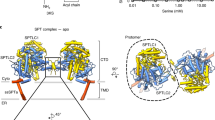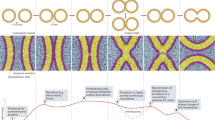Abstract
Functioning and processing of membrane proteins critically depend on the way their transmembrane segments are embedded in the membrane1. Sphingolipids are structural components of membranes and can also act as intracellular second messengers. Not much is known of sphingolipids binding to transmembrane domains (TMDs) of proteins within the hydrophobic bilayer, and how this could affect protein function. Here we show a direct and highly specific interaction of exclusively one sphingomyelin species, SM 18, with the TMD of the COPI machinery protein p24 (ref. 2). Strikingly, the interaction depends on both the headgroup and the backbone of the sphingolipid, and on a signature sequence (VXXTLXXIY) within the TMD. Molecular dynamics simulations show a close interaction of SM 18 with the TMD. We suggest a role of SM 18 in regulating the equilibrium between an inactive monomeric and an active oligomeric state of the p24 protein3,4, which in turn regulates COPI-dependent transport. Bioinformatic analyses predict that the signature sequence represents a conserved sphingolipid-binding cavity in a variety of mammalian membrane proteins. Thus, in addition to a function as second messengers, sphingolipids can act as cofactors to regulate the function of transmembrane proteins. Our discovery of an unprecedented specificity of interaction of a TMD with an individual sphingolipid species adds to our understanding of why biological membranes are assembled from such a large variety of different lipids.
This is a preview of subscription content, access via your institution
Access options
Subscribe to this journal
Receive 51 print issues and online access
$199.00 per year
only $3.90 per issue
Buy this article
- Purchase on Springer Link
- Instant access to full article PDF
Prices may be subject to local taxes which are calculated during checkout




Similar content being viewed by others
References
Coskun, U. & Simons, K. Cell membranes: the lipid perspective. Structure 19, 1543–1548 (2011)
Popoff, V., Adolf, F., Brugger, B. & Wieland, F. COPI budding within the Golgi stack. Cold Spring Harb. Perspect. Biol. 10.1101/cshperspect.a005231 (15 August 2011)
Béthune, J. et al. Coatomer, the coat protein of COPI transport vesicles, discriminates endoplasmic reticulum residents from p24 proteins. Mol. Cell. Biol. 26, 8011–8021 (2006)
Reinhard, C. et al. Receptor-induced polymerization of coatomer. Proc. Natl Acad. Sci. USA 96, 1224–1228 (1999)
Brügger, B. et al. Evidence for segregation of sphingomyelin and cholesterol during formation of COPI-coated vesicles. J. Cell Biol. 151, 507–518 (2000)
Beck, R., Ravet, M., Wieland, F. T. & Cassel, D. The COPI system: molecular mechanisms and function. FEBS Lett. 583, 2701–2709 (2009); corrigendum. 583, 3541 (2009)
Haberkant, P. et al. Protein-sphingolipid interactions within cellular membranes. J. Lipid Res. 49, 251–262 (2008)
Thiele, C., Hannah, M. J., Fahrenholz, F. & Huttner, W. B. Cholesterol binds to synaptophysin and is required for biogenesis of synaptic vesicles. Nature Cell Biol. 2, 42–49 (2000)
Kuerschner, L. et al. Polyene-lipids: a new tool to image lipids. Nature Methods 2, 39–45 (2005)
Russ, W. P. & Engelman, D. M. The GxxxG motif: a framework for transmembrane helix-helix association. J. Mol. Biol. 296, 911–919 (2000)
Senes, A., Gerstein, M. & Engelman, D. M. Statistical analysis of amino acid patterns in transmembrane helices: the GxxxG motif occurs frequently and in association with β-branched residues at neighboring positions. J. Mol. Biol. 296, 921–936 (2000)
Jones, D. T., Taylor, W. R. & Thornton, J. M. A mutation data matrix for transmembrane proteins. FEBS Lett. 339, 269–275 (1994)
Contreras, F. X., Basanez, G., Alonso, A., Herrmann, A. & Goni, F. M. Asymmetric addition of ceramides but not dihydroceramides promotes transbilayer (flip-flop) lipid motion in membranes. Biophys. J. 88, 348–359 (2005)
Bakrac, B. et al. A toxin-based probe reveals cytoplasmic exposure of Golgi sphingomyelin. J. Biol. Chem. 285, 22186–22195 (2010)
Li, X. M., Smaby, J. M., Momsen, M. M., Brockman, H. L. & Brown, R. E. Sphingomyelin interfacial behavior: the impact of changing acyl chain composition. Biophys. J. 78, 1921–1931 (2000)
Niemelä, P., Hyvönen, M. T. & Vattulainen, I. Structure and dynamics of sphingomyelin bilayer: insight gained through systematic comparison to phosphatidylcholine. Biophys. J. 87, 2976–2989 (2004)
Niemelä, P. S., Hyvönen, M. T. & Vattulainen, I. Influence of chain length and unsaturation on sphingomyelin bilayers. Biophys. J. 90, 851–863 (2006)
Presley, J. F. et al. ER-to-Golgi transport visualized in living cells. Nature 389, 81–85 (1997)
Scales, S. J., Pepperkok, R. & Kreis, T. E. Visualization of ER-to-Golgi transport in living cells reveals a sequential mode of action for COPII and COPI. Cell 90, 1137–1148 (1997)
Keller, P., Toomre, D., Diaz, E., White, J. & Simons, K. Multicolour imaging of post-Golgi sorting and trafficking in live cells. Nature Cell Biol. 3, 140–149 (2001)
Simpson, J. C. et al. An RNAi screening platform to identify secretion machinery in mammalian cells. J. Biotechnol. 129, 352–365 (2007)
Jackson, M. E. et al. The KDEL retrieval system is exploited by Pseudomonas exotoxin A, but not by Shiga-like toxin-1, during retrograde transport from the Golgi complex to the endoplasmic reticulum. J. Cell Sci. 112, 467–475 (1999)
Acknowledgements
The authors would like to thank T. Sachsenheimer for technical assistance, A. Brodde for help with lipid synthesis, D. Cassel for comments on the manuscript, and the members of the Wieland laboratory for discussion. This work was supported by a grant of the German research foundation (DFG, TRR83) to B.B. and F.W. and by ERC grants to E.L. (209825) and G.v.H. (AdG232648); F.-X.C. was supported by a FEBS fellowship and A.M.E. by the Peter and Traudl Engelhorn foundation.
Author information
Authors and Affiliations
Contributions
F.-X.C., A.M.E. and P.H. designed and performed the experiments. P.B. performed the bioinformatics analyses under the supervision of A.E., G.v.H. and A.M.E.; E.L. designed, performed and interpreted molecular dynamics simulation experiments. B.G. performed in vivo crosslinking experiments. C.Th. provided reagents and helped to establish photolabelling and FRET experiments. C.Ti. and R.P. provided reagents and tools and supported A.M.E. concerning VSV-G experiments. F.W. and B.B. designed the experiments and wrote the manuscript.
Corresponding authors
Ethics declarations
Competing interests
The authors declare no competing financial interests.
Supplementary information
Supplementary Information
The file contains a Supplementary Discussion, Supplementary Methods, Supplementary References, Supplementary Table 1, legends for Supplementary Movies 1-2 and Supplementary Figures 1-12 with legends. (PDF 24139 kb)
Supplementary Movie 1
The movie shows the dynamics of the SM 18:0-p24TMD interaction. A rigid interaction of the headgroup with Y21 is observed, while the chain packing to V13/T16/L17 appears to be dynamic in nature. The long chain wraps around the p24 backbone, with the end of the chain pointing to the centre of the bilayer (see Supplementary Information file for full legend). (MOV 3157 kb)
Supplementary Movie 2
The movie shows the dynamics of SM 14:0 close to the p24TMD. The headgroup interacts with Y21 from below, which rotates the chains out from the TMD (see Supplementary Information file for full legend). (MOV 2999 kb)
Rights and permissions
About this article
Cite this article
Contreras, FX., Ernst, A., Haberkant, P. et al. Molecular recognition of a single sphingolipid species by a protein’s transmembrane domain. Nature 481, 525–529 (2012). https://doi.org/10.1038/nature10742
Received:
Accepted:
Published:
Issue Date:
DOI: https://doi.org/10.1038/nature10742
This article is cited by
-
How ceramides affect the development of colon cancer: from normal colon to carcinoma
Pflügers Archiv - European Journal of Physiology (2024)
-
Regulation of membrane protein structure and function by their lipid nano-environment
Nature Reviews Molecular Cell Biology (2023)
-
Waxy lipids and waning insulin secretion
Nature Cell Biology (2023)
-
Sphingomyelin 16:0 is a therapeutic target for neuronal death in acid sphingomyelinase deficiency
Cell Death & Disease (2023)
-
Tetraspanin Tspan8 restrains interferon signaling to stabilize intestinal epithelium by directing endocytosis of interferon receptor
Cellular and Molecular Life Sciences (2023)
Comments
By submitting a comment you agree to abide by our Terms and Community Guidelines. If you find something abusive or that does not comply with our terms or guidelines please flag it as inappropriate.



